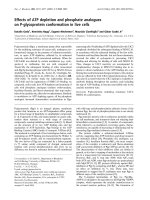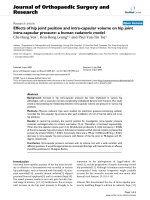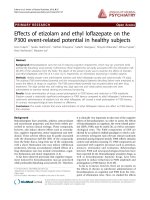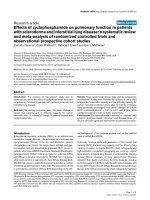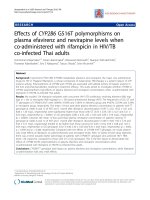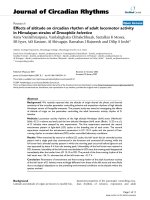Báo cáo y học: " Effects of Cowpea mottle virus and Cucumber mosaic virus on six Soybean (Glycine max L.) cultivars" docx
Bạn đang xem bản rút gọn của tài liệu. Xem và tải ngay bản đầy đủ của tài liệu tại đây (410.75 KB, 5 trang )
BioMed Central
Page 1 of 5
(page number not for citation purposes)
Virology Journal
Open Access
Research
Effects of Cowpea mottle virus and Cucumber mosaic virus on six
Soybean (Glycine max L.) cultivars
Olawale Arogundade*, Samuel O Balogun and Taiye H Aliyu
Address: Department of Crop Protection, Faculty of Agriculture, University of Ilorin, Tanke, Ilorin, Kwara State, 23401(031), Nigeria
Email: Olawale Arogundade* - ; Samuel O Balogun - ;
Taiye H Aliyu -
* Corresponding author
Abstract
The study was carried out to determine the comparative pathogenic response of six cultivars of
soybean; TGx 1844-18E, TGx 1448-2E, TGx 1910-8F, TGx 1019-2EN, TGx 1910-8F and TGx
1876-4E to single and mixed infections with cowpea mottle virus and cucumber mosaic virus. The
experiment was conducted in the screenhouse at the crop production pavilion, Faculty of
Agriculture, University of Ilorin, Ilorin, Kwara state Nigeria. The results of the experiment revealed
that all soybean cultivars were susceptible to single and mixed infection of the two viruses but to
seemingly different extent. The single infection with cowpea mottle virus (CMeV), however, caused
the most severe symptoms on the soybean cultivars. Cucumber mosaic virus (CMV) alone was not
as severe as the CMeV. The mixed infection of CMeV and CMV did not cause higher severity than
CMeV alone indicating that there was little or no synergistic effect between the two viruses on
soybean.
Introduction
Soybean, Glycine max (L) Merrill, is one of the oldest of
cultivated leguminous Oilseed belonging to the family
Fabaceae. It grows in tropical, subtropical, and temperate
climates. It has 40 chromosomes (2n = 40) and is a self-
fertilized species with less than 1% out-crossing [1]. It is
an annual plant that varies in growth habit and height. It
may grow prostrate, not growing higher than 20 cm, or
even up to 2 meters in height [1].
Soybean is a source of high quality and inexpensive pro-
tein, which is about 40% of the seed [2]. The oil and pro-
tein contents in soybean together account for about 60%
of dry soybean seed by weight, protein at 40% and oil at
20%. The remainder consists of 35% carbohydrate and
about 5% ash. The oil is high in essential fatty acids,
devoid of cholesterol and constitutes more than 50% of
the world's edible vegetable oil in trade [3]. All these
advantages notwithstanding; the crop is faced with dis-
eases such as rust, red leaf blotch, frog-eye leafspot, bacte-
rial pustule, bacterial blight, and soybean mosaic virus
among other virus diseases, are problems to be resolved in
soybean. Soybean mosaic virus (SMV) is the most fre-
quently isolated virus of soybean, it probably occurs
wherever soybean is grown, the symptoms vary according
to the particular viral strain, host genotype, weather and
time of infection [4]. Cowpea mild mottle virus (CCMV)
has been reported on soybean from Nigeria [5,6]. Cowpea
mottle virus is of localized importance on cowpea in
Nigeria [7].
Published: 10 December 2009
Virology Journal 2009, 6:220 doi:10.1186/1743-422X-6-220
Received: 17 July 2009
Accepted: 10 December 2009
This article is available from: />© 2009 Arogundade et al; licensee BioMed Central Ltd.
This is an Open Access article distributed under the terms of the Creative Commons Attribution License ( />),
which permits unrestricted use, distribution, and reproduction in any medium, provided the original work is properly cited.
Virology Journal 2009, 6:220 />Page 2 of 5
(page number not for citation purposes)
Cucumber mosaic virus (CMV) is worldwide in distribu-
tion. The virus causing cucumber mosaic has a wider
range of hosts and attacks a greater variety of vegetables,
ornamentals, weeds, and other plants than other viruses
[8]. In view of the fact that mixed infections involving
some of these viruses are possible under the tropical envi-
ronments of Nigeria, but there is dearth of information on
such a phenomenon, the objective of this study was to
examine the effects of single and mixed infection by
CMeV and CMV on growth and yield parameters of six
Cultivars of Soybean in Nigeria.
Materials and methods
Sourcing of seeds and propagation of soybean
The seeds of soybean cultivars; cv TGx 1844-18E, cv TGx
1019-2EN, cv TGx 1910-8F, cv TGx 1844-4E, cv TGx 1448-
2E and cv TGx 1876-4E used in the experiment were col-
lected from the International Institute of Tropical Agricul-
ture (IITA), Ibadan, Nigeria. The seeds were sown in a 5
litre plastic buckets filled with sterilized sandy loam soil
augmented with 5 g NPK fertilizer per litre soil at seedling
at the rate of four seeds per pot and later thinned to two
plants per pot. The pots were arranged in the screenhouse
under ambient tropical temperature, lighting and humid-
ity regimes between the months of December 2007 and
April 2008.
Source and propagation of inoculum and inoculation
procedures
The CMeV and CMV isolates were extracted from infected
leaves obtained from the stock of the Plant Pathology Lab-
oratory at the International Institute for Tropical Agricul-
ture (IITA). Infected leaf sample was macerated in
phosphate buffer (pH 7.2) at the rate of 1 g/5 ml of buffer
in pre-cooled mortar and pestle. The inoculation was
done by mechanical transmission of virus through sap.
The sap was applied on the surfaces of the oldest leaves
previously dusted which carborundum. The sap was
applied by rubbing the leaves gently with a cotton wool
dipped in the sap. Inoculated plants were rinsed thereafter
with water. Plants that were mock-inoculated with buffer
only served as control. Inoculation was done two weeks
after planting.
Data collection and analysis
Data were collected at the time of infection as well as on
weekly basis. Plant height and number of leaves were
taken weekly over a period of 9 weeks after inoculation.
Yield parameters such as number of pods, dry weight of
pods (g) and dry weight of grain (g) were also taken. The
pods were harvested, dried and weighed with the aid of an
electronic balance. The pods were threshed manually and
weighed, the treatment design was a factorial fitted into a
randomized complete block design (RCBD). All data were
subjected to analysis of variance (ANOVA) having regards
for the factorial nature of the treatment design and the sig-
nificant differences between them were determined at P <
0.05, using the new Duncan's Multiple Range test.
Results
The six cultivars used for the experiment showed sympto-
matic response to infection by Cowpea mottle virus
(CMeV) and Cucumber mosaic virus (CMV) under single
and mixed infection situations but to seemingly different
extent. TGx 1019-2EN and TGx 1448-2E were both sus-
ceptible to both mixed and single infection, TGx 1844-
18E was susceptible to single infection, TGx 1910-8F was
susceptible to mixed infection while TGx 1876-4E and
TGx 1844-4E were mildly tolerant to both single and
mixed infection.
In susceptible cultivars infection with CMeV manifested
as leaf mottling, which progressed to leaf wrinkling. Such
leaves appeared relatively smaller in size than normal
leaves. Generally, plants that were susceptible to infection
with CMV alone manifested only mild mosaic symptoms
while those plants that were susceptible to mixed infec-
tion with CMV and CMeV showed a combination of
Effect on growthFigure 1
Effect on growth. Soybean cv TGx 1019-2EN under CMeV
infection.
Virology Journal 2009, 6:220 />Page 3 of 5
(page number not for citation purposes)
mosaic, necrosis and stunting as were also observed in
severe CMeV infections (Figure 1). It was observed that
CMeV induced striking symptoms even on the fruit setting
and the fruits of severely infected plants. Figure 2 shows cv
TGx 1019-2EN manifesting serious distortions on the fruit
set. All mock inoculated control plants were free from the
infections and had normal fruit set as shown in figure 3.
The main effect of variety and inoculation on growth
parameters as at 7 weeks after inoculation as shown
(Table 1), ranging from week 2 through week 7 after inoc-
ulation, viral inoculated plants were generally signifi-
cantly shorter than the healthy control. However, there
Table 1: Effect of variety and viral inoculation on the height of soybean at different times after inoculation
Weeks after inoculation
Variety 0 1 2 3 4 5 6 7
TGx 1910 8F 6.2 h 9.0 hi 13. 6 f 21.6 efg 31.2cde 40.5bcd 52.8a 55.6a
TGx 1448 2E 10.0de 12.3de 16.3cde 22.6def 27.3ef 29.3g 34.3cde 36.9de
TGx1844 18E 14.8a 17.2a 20.6b 28.6bc 33.2bcd 42.2d 50.7a 54.4a
TGx 1844 4E 9.1ef 11.5def 17.5c 24.1de 31.2cde 41.8bc 48.8a 50.7ab
TGx 1019 2EN 8.2fg 11.2efg 15.5cdef 22.6def 25.3f 29.3g 32.8def 36.3de
TGx 1876 4E 5.6h 8.2i 13.4f 20.3fg 29.4cdef 46.9a 56.4a 64.2a
S. E 0.37 0.40 0.67 1.08 1.75 1.43 1.57 1.50
Viral Treatment
CMeV 10.6a 12.9a 17.5b 24.1b 30.8b 36.5b 39.7c 40.8c
CMV 9.7b 12.1b 16.8b 24.5b 31.2b 38.1b 43.1b 43.7b
CMeV + CMV 9.3b 11.9b 16.8b 23.9b 30.4b 36.3b 39.8c 41.7c
Control 9.8b 12.4b 19.0a 28.0a 36.2a 41.2a 46.4a 54.4a
S. E 0.18 0.20 0.32 0.52 0.85 0.70 0.76 0.73
Means followed by the same letter(s) are not significantly different at P < 0.05 using the new Duncan's multiple range test
Effects on yield attributeFigure 3
Effects on yield attribute. Fruiting patterns of healthy
Soybean plant.
Effects on yield attributeFigure 2
Effects on yield attribute. Fruiting pattern of diseased
Soybean plant.
Virology Journal 2009, 6:220 />Page 4 of 5
(page number not for citation purposes)
were no significant differences between inoculated plants
until the 6th and 7th week. Even then, those inoculated
singly with cowpea mottle virus and those inoculated
with a mixture of cowpea mottle virus and cucumber
mosaic virus were not significantly different. Considera-
tion of the different treatment combinations showed that
the soybean plants responded in various ways to the dif-
ferent inoculation regimes (Treatments). It is apparent
however that those plants inoculated with CMeV were the
most severely affected.
In the number of leaves, analysis of the main effect of
inoculation (i.e. regardless of the variety involved) shows
that there were generally significant differences between
the viral inoculated soybean plants from week 2 through
week 5 after inoculation. However, there were no signifi-
cant differences between the control and CMV inoculated
plants at 4
th
, 6
th
and 7
th
week after inoculation. There was
no significant difference between all treatments including
the control at week 8 as shown in Table 2.
Effects on yield parameters
Table 3 shows the main effect of variety and inoculation
on number of pods, weight of pods and weight of grain.
As with the growth parameters, analysis of variance shows
that the yield parameters in mock inoculated plants dif-
fered significantly from those in viral inoculated ones
with mock inoculated plants having higher values com-
pared to the viral inoculated ones.
Discussion
Recently, there has not been a record on the response of
soybean cultivars to CMV in this part of the world. How-
ever, it has been reported that soybean in this part of the
Table 3: Effect of variety and viral inoculation on yield parameters
Variety No. of pods Dry weight of pods (g) Dry weight of grains (g)
TGx 1910 8F 19.8a 5.2a 3.9a
TGx 1448 2E 14.7c 4.4abc 2.9abc
TGx1844 18E 8.3d 2.8de 1.7f
TGx 1844 4E 19.3ab 5.0a 3.8a
TGx1019 2EN 16.8abc 5.0a 3.5a
TGx1876 4E 15.4c 5.2a 3.4a
S.E 1.09 0.35 0.22
Viral Treatment
CMeV 10.9c 3.1b 1.9b
CMV 13.0b 3.6b 2.1b
CMeV + CMV 12.3b 3.2b 1.9b
Control 18.1a 6.7a 5.3a
S.E 0.53 0.17 0.10
Means followed by the same letter(s) are not significantly different at P < 0.05 using the new Duncan's multiple range test
Table 2: Effect of variety and viral inoculation on number of leaves of soybean at different times after inoculation
Weeks after inoculation
Variety 0 1 2 3 4 5 6 7 8 9
TGx 1910 8F 2.1f 3.2cd 4.5a 6.7a 8.0a 8.4b 9.2bc 8.8b 9.0b 8.6b
TGx 1448 2E 2.3ef 3.0de 3.9cdef 5.4cdef 6.2efg 7.3c 7.8de 7.7cd 7.8cd 6.9cd
TGx1844 18E 2.0f 3.0de 3.9cdef 5.8bcde 6.3def 7.3c 8.2cd 7.8cd 7.5cde 6.7cd
TGx 1844 4E 2.6cd 3.0de 3.9cdef 5.2def 6.7cde 8.1b 9.8b 8.2bc 8.6bc 7.4bcd
TGx1019 2EN 2.3ef 3.2cd 3.9cdef 5.2def 5.4g 5.7e 7.6def 7.3cd 7.5cde 7.1cd
TGx1876 4E 2.0f 3.0de 4.0cdef 5.5bcdef 7.0bcd 9.8a 11.0a 12.0a 13.0a 10.9a
S.E 0.08 0.06 0.12 0.20 0.25 0.22 0.33 0.33 0.37 0.40
Viral Treatment
CMeV 2.5a 3.0b 3.7c 5.4b 6.5b 7.2b 7.5b 7.5b 7.6a 6.8a
CMV 2.5a 3.1b 4.0b 5.6b 6.8ab 7.4b 8.3a 7.6ab 7.1a 6.0b
CMeV + CMV 2.4b 3.1b 3.9b 5.4b 6.5b 7.3b 7.5b 7.4b 7.4a 5.9b
Control 2.5ab 3.5a 4.5a 6.1a 7.1a 7.8a 8.1a 8.0a 7.6a 6.1b
S.E 0.04 0.03 0.06 0.10 0.12 0.10 0.16 0.16 0.18 0.19
Means followed by the same letter(s) are not significantly different at P < 0.05 using the new Duncan's multiple range test
Publish with BioMed Central and every
scientist can read your work free of charge
"BioMed Central will be the most significant development for
disseminating the results of biomedical research in our lifetime."
Sir Paul Nurse, Cancer Research UK
Your research papers will be:
available free of charge to the entire biomedical community
peer reviewed and published immediately upon acceptance
cited in PubMed and archived on PubMed Central
yours — you keep the copyright
Submit your manuscript here:
/>BioMedcentral
Virology Journal 2009, 6:220 />Page 5 of 5
(page number not for citation purposes)
world is susceptible to cowpea mild mottle virus [4,1] but
nothing had been said about mixed infection of the two
viral diseases on soybean.
The experiment showed that all the cultivars of soybean
used are susceptible to CMV, CMeV as well as a mixed
infection with CMeV and CMV. The study showed that
soybean cultivars; TGx 1844-18E and TGx 1019-2EN are
highly susceptible to cowpea mottle virus as they
expressed some symptoms showing deviation from the
normal state of the plant physiology. Symptoms include
stunting, mosaic pattern, mottling of the leaves and mal-
formed leaves structures. Plants inoculated with CMV did
not cause development of visible symptoms on some of
the tested soybean cultivars. Smith [9] had also observed
that CMV does not normally cause visible symptoms on
Soybean. The soybean plants under mixed infection with
CMV and CMeV showed symptoms similar to those man-
ifested by plants under CMeV alone. This could be as a
result of the effect of the CMeV in the combination. It was
also an indication that the combination of the two viruses
was not synergistic in the soybean cultivars.
Abbreviations
CMeV: Cowpea mottle virus; CMV: Cucumber mosaic
virus; TGx: Tropical glycine crossing.
Competing interests
The authors declare that they have no competing interests.
Authors' contributions
O participated in the design of the study, performed the
inoculation, carried out data collection and drafted the
manuscript. SO conceived the study, participated in its
design, and coordination. TH participated in the design of
the study and performed the statistical analysis. All
authors read and approved the final manuscript.
Acknowledgements
We sincerely acknowledge the virology unit of the International Institute of
Tropical Agriculture (IITA), Ibadan, Nigeria for the provision of pure inoc-
ula used in this study. Also, the technical assistance by Alice, Idowu and
Gbemi all of Crop Protection Department, Faculty of Agriculture, Univer-
sity of Ilorin, Ilorin, Kwara State, Nigeria is acknowledged.
References
1. IITA: Annual Report Ibadan Nigeria. 2007 [ />cms/details/?a=1219&z=81&template=news_details.aspx-16k].
2. Weingartner KE: Processing, nutrition and utilization of soy-
bean. In Soybean for the tropics Edited by: Singh SR, Rachie KO, Dash-
iell KE. John Wiley and sons. New York; 1987:149-174.
3. Ogundipe HO, Weingartner K: Effect of the addition of soybean
on the nutritional status of selected traditional Nigerian
foods. Tropical Oilseed J 1992:67-73.
4. Sinclair JB, Schurtleff MC: Compendium of soybean disease. St.
Paul Minnesota. America Phytopathologyical Society 1975.
5. IITA: Annual Report Ibadan Nigeria IITA. 1975:136.
6. Anno Nyako FO: Identification, partial characterization and
some properties of a virus causing a mild mottle disease in
Glycine max (L) Merril in Nigeria and the Evaluation of local
and exotic cowpeas (Vigina unguiculata (L) Walp) for grain
legume viruses under natural conditions in Kumasi, Ghana.
1984.
7. Kareem KT, Taiwo MA: Interactions of viruses in cowpea:
Effects on growth and yield parameters. Virology journal 2007,
4:15.
8. Crescenzy A: Cucumber mosaic cucumovirus populations in
Italy under natural epidemic conditions and after a satellite-
mediated protection test. Plant Disease 1993, 77:28-33.
9. Smith KM: A text book of plant viral Disease. 3rd edition. Aca-
demic press New York; 1992.
